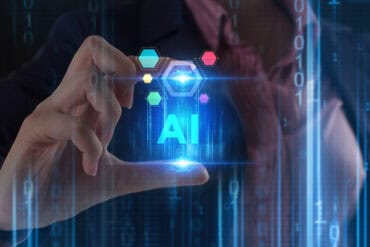
To maintain a competitive edge, companies should leverage the best of automation and the best of human emotion to create true brand loyalty and solidify consumer connections.
More than 59 zettabytes of data was produced and consumed in 2020, according to the International Data Corporation. And IDC predicts that the global population will create three times the amount of data over the next five years than it did in the last five. The vast amount of data and its exponential growth is simply too much for manual processes. The world needs advanced automation. But what does this mean for human operators? As data volumes increase and automation matures, what roles will be left for humans?
Artificial Intelligence (AI) visionary Elon Musk says that automation is the biggest threat to humanity and will cause mass job disruption, and former tech executive and presidential candidate Andrew Yang forecasts Depression-level unemployment due to AI’s ever-advancing skills. While there’s a kernel of truth to their statements, there are certain types of thinking and human-to-human connections that automation can’t replicate or replace. And these human qualities connect consumers to brands.
See also: Continuous Intelligence and the Automation Spectrum
Why modern enterprises need automation
The pandemic fast-tracked digital transformation and this transition to digital business processes has led to a vast amount of data production. Sorting and making sense of this data is too much for human operators.
The only way to keep pace with this data is by using smarter, automated tools. Automated processes handle low complexity, high volume tasks, and the newer category of AIOps applies AI and machine learning (ML) to large volumes of data from IT environments across enterprises. AIOps ingests data and analyzes information with intelligent algorithms, eliminating data silos, clustering data, detecting patterns, and defining systems’ faults.
The efficiencies gained with automation return significant value to IT teams and businesses. Rather than scrambling to find answers, automated technologies like AIOps provide teams with quick remediation strategies and free their time and attention to do complex tasks like upgrading systems, developing architectures, and creating the latest and greatest technologies.
From a broad business perspective, AIOps helps maintain service assurance, which is critical considering most modern enterprises derive at least some of their revenue through digital services. This automation also results in streamlined workflows, fewer errors, faster processing, shorter turnaround times, and less time and money spent on executing operational activities. In short, businesses can use automation to achieve more with less.
Despite popular opinion, company leadership typically doesn’t implement automation solely to reduce headcount. But still, change will happen. Just look at the rise of the internet over the last 40 years. While this technological breakthrough eliminated some jobs, it also brought about the invention of many others.
But what is a human’s role in this new world?
See also: Why Every Organization Needs Robotic Process Automation
Why automation can’t replace humans
Humans are a tribal species, and we need to connect with others. While AI can make life easier in a lot of ways, it can also leave people — and customers — craving the kind of authentic human-to-human connection, empathy, and emotional intelligence that automation can’t replace.
Bryan Kramer, a renowned social business strategist, global keynote speaker, executive coach, and best-selling author, recently joined me as a guest on my AIOps Evolution podcast. He shared his thoughts on the future of AI as it relates to the Human Business Movement: “There’s so much noise, it’s actually to our benefit to be more human and stand out. Artificial intelligence and humans need to work together and use being more ‘human’ to a competitive advantage.”
Business stakeholders should think about their customers’ journeys and leverage AI to build empathy into their processes. “If you want to build more customer loyalty, use AI or machine learning to spot human touchpoints that can give you more engagement,” says Kramer. “Technology should bring us closer to engagement, not farther away.”
My company automates a survey process that ends with a phone call between the client and me discussing the survey results and overall client satisfaction. We leverage AI to send surveys at prescribed intervals, record survey results, respond to the customer with different email templates depending on their level of satisfaction, and then schedule a time for me to contact the customer. As a CEO, this automation frees my time and my team’s time while the human-to-human contact allows me to engage with our clients and better understand their customer journeys. One of the biggest pieces of feedback I receive is that leadership never calls to talk.
How to get the best from humans and AI
Business leaders can stay ahead of the competition and transform today’s fickle customers into raving fans by surprising and delighting them in moments when they least expect it. If businesses can make customers feel something deeply, then chances are those customers will evangelize to their peers, creating valuable testimonials and referrals that transcend marketing initiatives.
But how? Businesses should focus on their strategies for digital performance management. In other words, they should analyze who is using the goods and services, how the consumer is interacting with these offerings, and what feelings it evokes. And business leaders should map out all customer touchpoints to understand the end-to-end pipeline from the second customers get behind their keyboards to type something into the system to the moment the systems deliver answers.
Stakeholders should step into consumers’ shoes to see how they’re feeling at every point. After all, enterprise processes will become clearer when IT teams look at deployed technology from a user perspective and ask, what are customers losing by us putting advanced technologies in place? Where could we add a human element? And could we leverage AI to inform us where more empathetic human moments could occur?
With most large enterprises all following the same automated IT playbook, an unexpected human touch will delight customers. And AI can still run in the background, creating efficient processes while increasing service assurance, decreasing downtime, and promising more innovative technologies.
There’s far too much data complexity for humans to monitor modern-day IT environments, making automation, including AIOps, critical to our always-on digital world. But humans also have a critical function in modern business by sparking joy, spontaneity, and empathy that’s beyond AI and ML’s reach. To maintain a competitive edge, companies should leverage the best of automation and the best of human emotion to create true brand loyalty and solidify consumer connections.





























